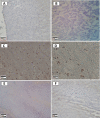Intravesical electromotive administration of botulinum toxin type A in improving the bladder and bowel functions: Evidence for novel mechanism of action
- PMID: 30998432
- PMCID: PMC7919921
- DOI: 10.1080/10790268.2019.1603490
Intravesical electromotive administration of botulinum toxin type A in improving the bladder and bowel functions: Evidence for novel mechanism of action
Abstract
Objective: To examine the hypothesis that what is the concomitant mechanism of action botulinum toxin type A (BoNTA) administration by intravesical electromotive into the bladder resulting in bladder function improvement. We also tried to confirm the possibility of retrograde trans-axonal transportation of toxin.Design: Animal study.Setting: Ten male rabbits were divided into two groups.Participants: Group 1 (G1) (n = 5) (BoNTA/EMDA), and group 2 (G2) (n = 5) the control group.Interventions: Animals in G1received 10 IU/Kg of intravesical BoNTA through a specific catheter for electromotive drug administration (BoNTA/EMDA). About 0.1-0.15 ml of toxin was diluted in 1 ml of distilled water. The maximum frequency of the device for drug solution delivery was set at 4 mA for 15 min. In G2 as the control group, the same procedure was performed to deliver normal saline to the bladder.Outcome measures: Multiple biopsies were taken from bladder's contiguous structures one month postoperatively. The immunohistochemical (IHC) evaluation was performed with anti-clostridium botulinum toxoid type A mouse IgM monoclonal antibody.Results: In specimens of G1, BoNTA penetrated through muscular layers of the bladder wall and the staining was uniform in the urothelium, interstitium, and muscular layers. Positive IHC staining showed that BoNTA was traced in the upper and lower spinal cord in addition to pelvic nerve, sacral nerve plexus, intestine wall, and pelvic floor muscle. In G2, all the specimens were intact in IHC staining.Conclusions: The presence of BoNTA in lower and upper spinal cord suggests the possibility of retrograde trans-axonal transfer of toxin to lower and upper neural pathways which may result in simultaneous improvement in bladder and bowel functions.
Keywords: Bladder; Botulinum toxin type A; Defecation; Immunohistochemistry; Urination.
Figures


Similar articles
-
Botulinum Toxin Type A Therapy: Intravesical Injection or Electromotive Drug Administration.Urology. 2020 Aug;142:190-194. doi: 10.1016/j.urology.2020.04.104. Epub 2020 May 11. Urology. 2020. PMID: 32437774
-
Intravesical Electromotive Botulinum Toxin Type "A" Administration for Management of Urinary Incontinence Secondary to Neuropathic Detrusor Overactivity in Children: Long-term Follow-up.Urology. 2018 Apr;114:167-174. doi: 10.1016/j.urology.2017.11.039. Epub 2017 Dec 8. Urology. 2018. PMID: 29229221
-
Intravesical Electromotive Botulinum Toxin Type A (Dysport) Administration in Children With Myelomeningocele.Urology. 2019 Oct;132:210-211. doi: 10.1016/j.urology.2019.06.033. Epub 2019 Jul 9. Urology. 2019. PMID: 31299327
-
[Guidelines for practical usage of botulinum toxin type A (BoNTA) for refractory idiopathic overactive bladder management].Prog Urol. 2013 Dec;23(17):1457-63. doi: 10.1016/j.purol.2013.10.006. Epub 2013 Nov 7. Prog Urol. 2013. PMID: 24286546 French.
-
Botulinum toxin A for the Treatment of Overactive Bladder.Toxins (Basel). 2016 Feb 29;8(3):59. doi: 10.3390/toxins8030059. Toxins (Basel). 2016. PMID: 26938559 Free PMC article. Review.
Cited by
-
Pharmacological Management of Urinary Incontinence: Current and Emerging Treatment.Clin Pharmacol. 2021 Nov 25;13:209-223. doi: 10.2147/CPAA.S289323. eCollection 2021. Clin Pharmacol. 2021. PMID: 34858068 Free PMC article. Review.
-
Ultrasound guided transabdominal botulinum toxin injection for refractory overactive bladder treatment.Sci Rep. 2025 May 25;15(1):18162. doi: 10.1038/s41598-025-03116-2. Sci Rep. 2025. PMID: 40415074 Free PMC article.
-
Validation of the Barthel Index in Chinese nursing home residents: an item response theory analysis.Front Psychol. 2024 Apr 30;15:1352878. doi: 10.3389/fpsyg.2024.1352878. eCollection 2024. Front Psychol. 2024. PMID: 38746915 Free PMC article.
-
Treating Lower Urinary Tract Symptoms in Older Adults: Intravesical Options.Drugs Aging. 2023 Mar;40(3):241-261. doi: 10.1007/s40266-023-01009-5. Epub 2023 Mar 6. Drugs Aging. 2023. PMID: 36879156 Free PMC article. Review.
References
-
- Gamé X, Mouracade P, Chartier-Kastler E, Viehweger E, Moog R, Amarenco G, et al. . Botulinum toxin-A intradetrusor injections in children with neurogenic detrusor overactivity/neurogenic overactive bladder: A systematic literature review. J Pediatr Urol. 2009;5(3):156–64. doi: 10.1016/j.jpurol.2009.01.005 - DOI - PubMed
-
- Tubaro A, Puccini F, De Nunzio C.. The management of overactive bladder: percutaneous tibial nerve stimulation, sacral nerve stimulation, or botulinum toxin? Curr Opin Urol. 2015 Jul;25(4):305–10. PubMed PMID: 26049873. - PubMed
-
- Hassouna T, Gleason JM, Lorenzo AJ.. Botulinum toxin A’s expanding role in the management of pediatric lower urinary tract dysfunction. Curr Urology Rep. 2014;15(8):1–7. - PubMed
MeSH terms
Substances
LinkOut - more resources
Full Text Sources
Medical
